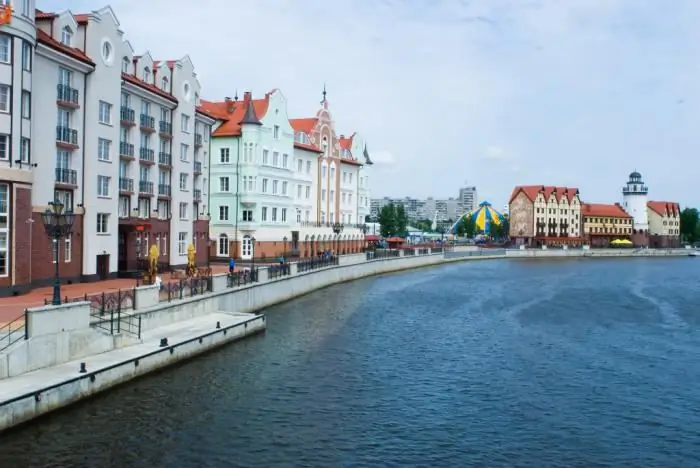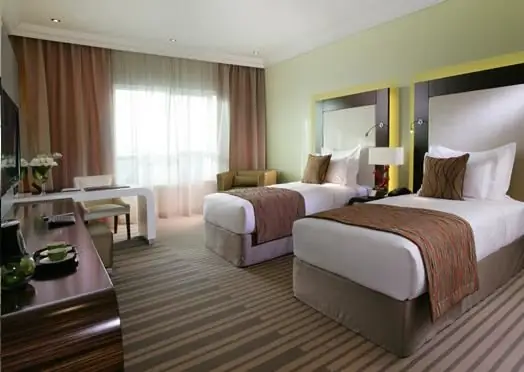- Author Harold Hamphrey [email protected].
- Public 2023-12-17 10:06.
- Last modified 2025-01-24 11:10.
Royal Gate (Kaliningrad) is one of the most famous architectural sights of the most western city of Russia. In appearance, the structure resembles either a triumphal arch or a miniature hunting castle.
A brief history of the fortifications of Kaliningrad
The first castle on the banks of the Pregolya River appeared in the middle of the 13th century. However, the idea to turn the entire Koenigsberg into an impregnable fortress arose among its inhabitants at the beginning of the 19th century (after Napoleon's troops easily occupied it). In 1841, the city was visited by the monarch Friedrich Wilhelm IV, to whom the townspeople turned with a request to build a complex of powerful fortifications around.
Soon large-scale work began on the construction of the fortifications of Koenigsberg, which was supposed to become a reliable stronghold of East Prussia. The city ring of fortifications was divided into several fronts. Each of them included earthen ramparts, bastions, towers, artillery positions, as well as gates for passage.

With the development of artillery, it was decided to surround Koenigsberg with a beltforts. It was assumed that they would additionally protect the city with the help of long-range shelling of the enemy. Soon, 15 brick forts (12 large and three small) grew up in the vicinity of modern Kaliningrad. They were all connected by a 43 km long ring road.
The twentieth century was a period of rapid development and modernization of weapons, as well as techniques for conducting military operations. Thus, the fortifications of Koenigsberg became outdated very quickly and, in fact, they never fulfilled their intended role in history.
At the beginning of the 20th century, the internal defense belt of Koenigsberg was bought by the city administration from the military. Most of the fortifications and bastions were dismantled, the ramparts were turned into streets and boulevards. Fortunately, the King's Gate has been preserved. They will be discussed further.
Royal Gate (Kaliningrad): description and location
Seven gates of the inner belt of fortifications dating back to the middle of the 19th century have survived to this day in Kaliningrad-Koenigsberg. These are the Rossgarten Gate in the north, the Ausfal and Railway Gates in the west, the Brandenburg Gate (in the southwest), the Friedland Gate (in the south), the Sackheim and King's Gate (in the east). All of them were built between 1840 and 1850 in neo-gothic style.
King's Gate is symbolic for the city, it is the most beautiful and expressive of all the others. The author of the structure is General Ernst Ludwig von Aster. The sculptures were made by Wilhelm Ludwig Stürmer.

Gate located in Lithuanianshaft, between the Grolman bastion and the channel of Novaya Pregolya.
History of the construction of the Royal Gate
The gate got its name from the name of the road of the same name. It was called Royal because the Prussian kings were heading from the city along it (the road led towards the suburbs of Devau).
The laying of the first stone of the future building took place in 1843. At the same time, King Frederick William IV himself was present. At the time of construction, earthen ramparts adjoined the gates on both sides. Later, with the development of road transport, they were leveled. The road was laid next to a brick structure. Thus, the gate turned out to be an isolated, separate building.

By the beginning of the 90s, the King's Gate was badly dilapidated and required serious reconstruction. Restoration work began only in the fall of 2004. About 20 million rubles were allocated for them from the budget.
Architecture features and interesting facts
The gate is a red brick structure, consisting of a wide passage (4.5 meters) and casemates located on the sides of it. The building from the outside is reinforced with embrasures. Horizontally, the gate is divided into two parts by a cornice belt. The upper edges of the roofs of the casemates, as well as the driveway, are crowned with battlements and miniature turrets.
The upper tier of the gate is decorated with recesses, in which sculptures of King Otakar II of the Czech Republic, King Frederick I of Prussia and Duke Albrecht I of Prussia are placed.

In 2005year, after the restoration work was completed, a case with a message to posterity was placed in the wall of the Royal Gate. One of the entries in it belongs to Russian President Vladimir Putin.
According to one version, it is in the Royal Gate that there may be numerous valuables hidden by the German army during the retreat from the city in 1945.
King's Gate Museum and Opening Hours
In the winter of 2005, the gate became a branch of the Museum of the World Ocean. The building housed several expositions dedicated to the development of the city's fortifications, as well as visits to Kaliningrad by various famous personalities, in particular, the embassy of Tsar Peter the Great to Europe.
The museum also constantly hosts various events, solemn ceremonies and meetings of foreign guests. The ancient Royal Gates have become a kind of “gateway” in Russia for Western colleagues. Museum address: Frunze street, 112. You can visit its expositions daily from 11 am to 6 pm (except Monday and Tuesday).






